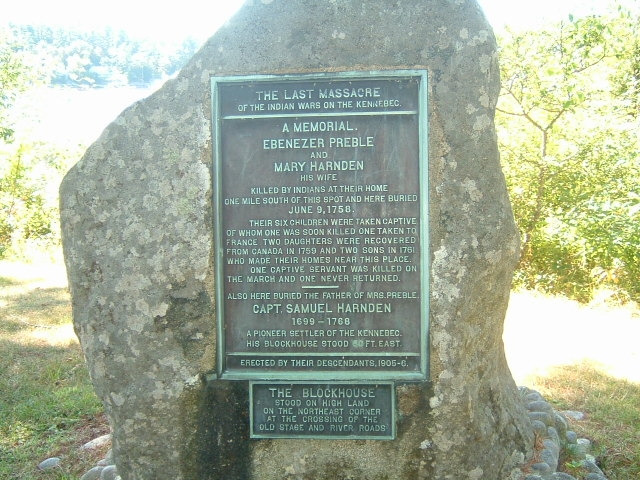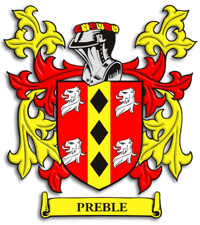* His [Ebenezer's]
great-grandson, Capt. Geo. A. Preble, wrote me in 1851, that
Eben had two sons, Ebenezer and Samuel; and three daughters,
Polly, Rebecca and Mehitable, and that he was shot by the
Indians while at work in the field, his wife was killed in
the house, and the children all carried to Quebec, where
they remained prisoners four or five years. At the end of
the war they were all brought back by their grandfather,
Brigadier General Harnden (who went to Quebec for that
purpose), except the oldest daughter Mehitable, who was
taken by a French family, and became so much attached to
them that she refused to leave them and married in France.
The next daughter, Rebecca, married Thomas Motherwell, and
died April, 1829. The youngest daughter, Mary, died
unmarried at the age of ninety-six, at Woolwich, in Dec.
1843, retaining her health and mental powers unimpaired to
the last week of her life. She had a distinct recollection
of seeing the battle between the armies of Wolfe and
Montcalm on the heights of Abraham, and the capture of
Quebec.
Gen. Joseph Sewell's History of Bath (Maine Hist. Coll., Vol
II) has this account of the massacre:---
"In 1758 (sic) a strong
party of Indians landed on the head of the Island of
Arrowsic and killed a Mr. Preble and his wife who were out
in the field planting corn, and took his son and two
daughters captive. Mr. P. had a fort or block house there,
but so sudden was the attack that that he could not escape
to it. On their return the Indians proceeded to Harnden's
fort in Woolwich, which was near the Bath ferry, and there
took prisoner a Miss Motherwell, a relative of the young
captives, a girl of about eighteen years of age, who
happened to be without the garrison. One of the children
of Mr. Preble whom they seized at Arrowsic was an infant,
and crying for food as they supposed, they laid it in the
lap of the damsel they had last taken, and asked her to
impart to it the nourishment of a mother. With compassion
for the helpless infant, she replied she was not a mother.
The tears that fell from her cheek did not soften the
savage breast. He seized the child and dashing its head
against a rock, relieved it from further suffering. They
carried the other captives to Canada and sold them as
servants. After the cessation of Quebec to the British,
their grandfather Brigadier General Haranden [sic] went to
the province, obtained the release of the captives and
restored them."
In 1758, Watts's house and one other on the upper end of the
island, occupied by Mr. Preble, were the only dwelling
houses in Arrowsic, all the rest having been destroyed by
the Indians. |

